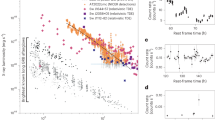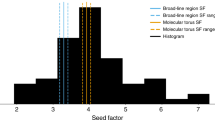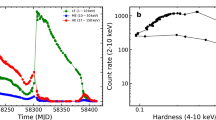Abstract
Accreting black holes emit highly collimated radio jets expanding at speeds approaching light speed. Some of these jets appear to be expanding at superluminal speeds due to geometric effects. While magnetic fields are thought to be responsible for collimating the ejecta, the mechanism that accelerates the material in these jets remains unexplained. For the galactic black hole GRS 1915+105 with a superluminal radio jet, it has been proposed that thermal instabilities in the accretion disk lead to the ejection of the inner parts of the disk into the jet. Here we use X-ray and radio observations over a 10-year period to reveal a strong correlation between (i) the radio flux that comes from the jet and the flux of the iron emission line that comes from the disk and (ii) the temperature of the hard X-ray corona and the amplitude of a high-frequency variability component that comes from the innermost part of the accretion flow. At the same time, the radio flux and the flux of the iron line are strongly anti-correlated with the temperature of the X-ray corona and the amplitude of the high-frequency variability component. Our findings show that the energy that powers this black hole system can be directed in different proportions either mainly to the X-ray corona or to the jet. These facts, plus our modelling of the variability in this source, suggest that in GRS 1915+105 the X-ray corona turns into the jet.
This is a preview of subscription content, access via your institution
Access options
Access Nature and 54 other Nature Portfolio journals
Get Nature+, our best-value online-access subscription
$29.99 / 30 days
cancel any time
Subscribe to this journal
Receive 12 digital issues and online access to articles
$119.00 per year
only $9.92 per issue
Buy this article
- Purchase on Springer Link
- Instant access to full article PDF
Prices may be subject to local taxes which are calculated during checkout




Similar content being viewed by others
Data availability
All the X-ray data used in this study are available from NASA’s High Energy Astrophysics Science Archive Research Center (https://heasarc.gsfc.nasa.gov/). The radio data used in this study are available at http://www.astro.rug.nl/~mariano/GRS_1915+105_Ryle_data_1995-2006.txt.
Code availability
The data reduction was done using HEADAS version 6.27, whereas the model fitting of energy, power and lag–energy spectra was done with XSPEC; both packages are available at the HEASARC website (https://heasarc.gsfc.nasa.gov/). The timing analysis was performed with the GHATS package developed by T.M.B. and is available upon request (http://astrosat.iucaa.in/~astrosat/GHATS_Package/Home.html). All figures were made in TOPCAT, a JAVA-based scientific plotting package developed by M. Taylor (http://www.star.bris.ac.uk/~mbt/topcat/).
Change history
04 April 2022
A Correction to this paper has been published: https://doi.org/10.1038/s41550-022-01668-1
References
Shakura, N. I. & Sunyaev, R. A. Black holes in binary systems. Observational appearance. Astron. Astrophys. 24, 337–355 (1973).
Sunyaev, R. A. & Titarchuk, L. G. Comptonization of X-rays in plasma clouds. Typical radiation spectra. Astron. Astrophys. 86, 121–138 (1980).
Fabian, A. C., Rees, M. J., Stella, L. & White, N. E. X-ray fluorescence from the inner disc in Cygnus X-1. Mon. Not. R. Astron. Soc. 238, 729–736 (1989).
Fabian, A. C. et al. Broad line emission from iron K- and L-shell transitions in the active galaxy 1H 0707-495. Nature 459, 540–542 (2009).
Greiner, J., Morgan, E. H. & Remillard, R. A. Rossi X-Ray Timing Explorer observations of GRS 1915+105. Astrophys. J. Lett. 473, L107 (1996).
Belloni, T., Klein-Wolt, M., Méndez, M., van der Klis, M. & van Paradijs, J. A model-independent analysis of the variability of GRS 1915+105. Astron. Astrophys. 355, 271–290 (2000).
Méndez, M. & van der Klis, M. The EXOSAT data on GX 339-4: further evidence for an ‘intermediate’ state. Astrophys. J. 479, 926–932 (1997).
Eikenberry, S. S., Matthews, K., Morgan, E. H., Remillard, R. A. & Nelson, R. W. Evidence for a disk-jet interaction in the microquasar GRS 1915+105. Astrophys. J. Lett. 494, L61–L64 (1998).
Mirabel, I. F. et al. Accretion instabilities and jet formation in GRS 1915+105. Astron. Astrophys. 330, L9–L12 (1998).
Fender, R. P., Spencer, R. E., Newell, S. J. & Tzioumis, A. K. High-resolution radio observations of the black hole candidate GX 339-4. Mon. Not. R. Astron. Soc. 286, L29–L32 (1997).
Mirabel, I. F. & Rodríguez, L. F. A superluminal source in the Galaxy. Nature 371, 46–48 (1994).
Fender, R. & Belloni, T. GRS 1915+105 and the disc-jet coupling in accreting black hole systems. Annu. Rev. Astron. Astrophys. 42, 317–364 (2004).
Reid, M. J. et al. A parallax distance to the microquasar GRS 1915+105 and a revised estimate of its black hole mass. Astrophys. J. 796, 2 (2014).
Pooley, G. G. & Fender, R. P. The variable radio emission from GRS 1915+105. Mon. Not. R. Astron. Soc. 292, 925–933 (1997).
Belloni, T., Méndez, M., King, A. R., van der Klis, M. & van Paradijs, J. A unified model for the spectral variability in GRS 1915+105. Astrophys. J. Lett. 488, L109–L112 (1997).
Casella, P., Belloni, T. & Stella, L. The ABC of low-frequency quasi-periodic oscillations in black hole candidates: analogies with Z sources. Astrophys. J. 629, 403–407 (2005).
Zhang, L. et al. A systematic analysis of the phase lags associated with the type-C quasi-periodic oscillation in GRS 1915+105. Mon. Not. R. Astron. Soc. 494, 1375–1386 (2020).
Trudolyubov, S. P. On the two types of steady hard X-ray states of GRS 1915+105. Astrophys. J. 558, 276–282 (2001).
Muno, M. P., Morgan, E. H. & Remillard, R. A. Quasi-periodic oscillations and spectral states in GRS 1915+105. Astrophys. J. 527, 321–340 (1999).
Fender, R. P. et al. MERLIN observations of relativistic ejections from GRS 1915+105. Mon. Not. R. Astron. Soc. 304, 865–876 (1999).
Stella, L. & Vietri, M. Lense-Thirring precession and quasi-periodic cscillations in low-mass X-ray binaries. Astrophys. J. Lett. 492, L59–L62 (1998).
Ingram, A., Done, C. & Fragile, P. C. Low-frequency quasi-periodic oscillations spectra and Lense-Thirring precession. Mon. Not. R. Astron. Soc. 397, L101–L105 (2009).
Neilsen, J. & Lee, J. C. Accretion disk winds as the jet suppression mechanism in the microquasar GRS 1915+105. Nature 458, 481–484 (2009).
Mizumoto, M., Ebisawa, K., Tsujimoto, M. & Inoue, H. Origin of the X-ray broad iron spectral feature in GRS 1915+105. Publ. Astron. Soc. Jpn 68, S16 (2016).
Merloni, A. & Fabian, A. C. Accretion disc coronae as magnetic reservoirs. Mon. Not. R. Astron. Soc. 321, 549–552 (2001).
Karpouzas, K. et al. The Comptonizing medium of the neutron star in 4U 1636 − 53 through its lower kilohertz quasi-periodic oscillations. Mon. Not. R. Astron. Soc. 492, 1399–1415 (2020).
Karpouzas, K. et al. A variable corona for GRS 1915+105. Mon. Not. R. Astron. Soc. 503, 5522–5533 (2021).
Malzac, J., Merloni, A. & Fabian, A. C. Jet–disc coupling through a common energy reservoir in the black hole XTE J1118+480. Mon. Not. R. Astron. Soc. 351, 253–264 (2004).
Matt, G., Fabian, A. C. & Reynolds, C. S. Geometrical and chemical dependence of K-shell X-ray features. Mon. Not. R. Astron. Soc. 289, 175–184 (1997).
Petrucci, P. O., Merloni, A., Fabian, A., Haardt, F. & Gallo, E. The effects of a Comptonizing corona on the appearance of the reflection components in accreting black hole spectra. Mon. Not. R. Astron. Soc. 328, 501–510 (2001).
Miniutti, G. & Fabian, A. C. A light bending model for the X-ray temporal and spectral properties of accreting black holes. Mon. Not. R. Astron. Soc. 349, 1435–1448 (2004).
Kylafis, N. D., Reig, P. & Papadakis, I. A quantitative explanation of the type-B QPOs in GX 339-4. Astron. Astrophys. 640, L16 (2020).
Reig, P. & Kylafis, N. D. Illumination of the accretion disk in black hole binaries: an extended jet as the primary source of hard X-rays. Astron. Astrophys. 646, A112 (2021).
Meier, D. L. Magnetically dominated accretion flows (MDAFS) and jet production in the lowhard state. Astrophys. Space Sci. 300, 55–65 (2005).
Kara, E. et al. The corona contracts in a black-hole transient. Nature 565, 198–201 (2019).
Wang, J. et al. Disk, corona, jet connection in the intermediate state of MAXI J1820+070 revealed by NICER spectral-timing analysis. Astrophys. J. Lett. 910, L3 (2021).
Vadawale, S. V. et al. On the origin of the various types of radio emission in GRS 1915+105. Astrophys. J. 597, 1023–1035 (2003).
Rodriguez, J., Corbel, S. & Tomsick, J. A. Spectral evolution of the microquasar XTE J1550−564 over its entire 2000 outburst. Astrophys. J. 595, 1032–1038 (2003).
Fender, R. P., Belloni, T. M. & Gallo, E. Towards a unified model for black hole X-ray binary jets. Mon. Not. R. Astron. Soc. 355, 1105–1118 (2004).
Levinson, A. & Blandford, R. On the jets associated with Galactic superluminal sources. Astrophys. J. Lett. 456, L29–L32 (1996).
Giannios, D., Kylafis, N. D. & Psaltis, D. Spectra and time variability of Galactic black-hole X-ray sources in the low/hard state. Astron. Astrophys. 425, 163–169 (2004).
Markoff, S., Nowak, M. A. & Wilms, J. Going with the flow: can the base of jets subsume the role of compact accretion disk coronae? Astrophys. J. 635, 1203–1216 (2005).
Hannikainen, D. C., Hunstead, R. W., Campbell-Wilson, D. & Sood, R. K. MOST radio monitoring of GX 339−4. Astron. Astrophys. 337, 460–464 (1998).
Corbel, S., Nowak, M. A., Fender, R. P., Tzioumis, A. K. & Markoff, S. Radio/X-ray correlation in the low/hard state of GX 339−4. Astron. Astrophys. 400, 1007–1012 (2003).
Gallo, E., Fender, R. P. & Pooley, G. G. A universal radio–X-ray correlation in low/hard state black hole binaries. Mon. Not. R. Astron. Soc. 344, 60–72 (2003).
Coriat, M. et al. Radiatively efficient accreting black holes in the hard state: the case study of H1743−322. Mon. Not. R. Astron. Soc. 414, 677–690 (2011).
Gallo, E., Miller, B. P. & Fender, R. Assessing luminosity correlations via cluster analysis: evidence for dual tracks in the radio/X-ray domain of black hole X-ray binaries. Mon. Not. R. Astron. Soc. 423, 590–599 (2012).
Gallo, E., Degenaar, N. & van den Eijnden, J. Hard state neutron star and black hole X-ray binaries in the radio:X-ray luminosity plane. Mon. Not. R. Astron. Soc. 478, L132–L136 (2018).
Merloni, A., Heinz, S. & di Matteo, T. A Fundamental Plane of black hole activity. Mon. Not. R. Astron. Soc. 345, 1057–1076 (2003).
Bariuan, L. G. C., Snios, B., Sobolewska, M., Siemiginowska, A. & Schwartz, D. A. The fundamental planes of black hole activity for radio-loud and radio-quiet quasars. Preprint at https://arxiv.org/abs/2201.04666 (2022).
Zhang, W., Jahoda, K., Swank, J. H., Morgan, E. H. & Giles, A. B. Dead-time modifications to fast Fourier transform power spectra. Astrophys. J. 449, 930–935 (1995).
Belloni, T. & Hasinger, G. An atlas of aperiodic variability in HMXB. Astron. Astrophys. 230, 103–119 (1990).
Nowak, M. A. Are there three peaks in the power spectra of GX 339-4 and Cyg X-1? Mon. Not. R. Astron. Soc. 318, 361–367 (2000).
Vaughan, B. A. & Nowak, M. A. X-ray variability coherence: how to compute it, what it means, and how it constrains models of GX 339−4 and Cygnus X-1. Astrophys. J. Lett. 474, L43–L46 (1997).
Nowak, M. A., Vaughan, B. A., Wilms, J., Dove, J. B. & Begelman, M. C. Rossi X-Ray Timing Explorer observation of Cygnus X-1. II. Timing analysis. Astrophys. J. 510, 874–891 (1999).
van den Eijnden, J., Ingram, A. & Uttley, P. Probing the origin of quasi-periodic oscillations: the short-time-scale evolution of phase lags in GRS 1915+105. Mon. Not. R. Astron. Soc. 458, 3655–3666 (2016).
van der Klis, M. et al. The complex cross-spectra of Cygnus X-2 and GX 5-1. Astrophys. J. Lett. 319, L13 (1987).
Wilms, J., Allen, A. & McCray, R. On the absorption of X-rays in the interstellar medium. Astrophys. J. 542, 914–924 (2000).
Verner, D. A., Ferland, G. J., Korista, K. T. & Yakovlev, D. G. Atomic data for astrophysics. II. New analytic FITS for photoionization cross sections of atoms and ions. Astrophys. J. 465, 487–498 (1996).
Miller, J. M. et al. NuSTAR spectroscopy of GRS 1915+105: disk reflection, spin, and connections to jets. Astrophys. J. Lett. 775, L45 (2013).
Mitsuda, K. et al. Energy spectra of low-mass binary X-ray sources observed from Tenma. Publ. Astron. Soc. Jpn 36, 741–759 (1984).
Zdziarski, A. A., Johnson, W. N. & Magdziarz, P. Broad-band γ-ray and X-ray spectra of NGC 4151 and their implications for physical processes and geometry. Mon. Not. R. Astron. Soc. 283, 193–206 (1996).
García, J. et al. Improved reflection models of black hole accretion disks: treating the angular distribution of X-rays. Astrophys. J. 782, 76 (2014).
Dauser, T., García, J., Parker, M. L., Fabian, A. C. & Wilms, J. The role of the reflection fraction in constraining black hole spin. Mon. Not. R. Astron. Soc. 444, L100–L104 (2014).
Dunn, R. J. H., Fender, R. P., Körding, E. G., Cabanac, C. & Belloni, T. Studying the X-ray hysteresis in GX 339-4: the disc and iron line over one decade. Mon. Not. R. Astron. Soc. 387, 545–563 (2008).
Acknowledgements
This work is part of the research programme Athena with project number 184.034.002, which is (partly) financed by the Dutch Research Council (NWO). F.G. is a researcher of CONICET, and acknowledges support by PIP 0113 (CONICET) and PICT-2017-2865 (ANPCyT). Y.Z. acknowledges support from a China Scholarship Council scholarship (201906100030). T.M.B. acknowledges financial contribution from agreement ASI-INAF n.2017-14-H.0 and from PRIN-INAF 2019 N.15, and thanks the Team Meeting at the International Space Science Institute (Bern) for fruitful discussions. D.A. acknowledges support from the Royal Society. We thank G. Pooley for making the radio data available. This research has made use of data and/or software provided by the High Energy Astrophysics Science Archive Research Center (HEASARC), which is a service of the Astrophysics Science Division at NASA/GSFC. This research made use of NASA’s Astrophysics Data System. We thank O. Blaes for discussions and ideas that helped us improve this manuscript.
Author information
Authors and Affiliations
Contributions
All authors contributed to interpretation of results and edited the manuscript. M.M. led the interpretation, obtained spectral parameters and wrote the manuscript. K.K. wrote the model that triggered this research, produced initial radio and timing plots, fitted r.m.s. and lag spectra and co-led the interpretation. F.G. produced initial three-dimensional radio, timing and spectral plots, fitted r.m.s. and lag spectra of the QPO and co-led the interpretation. M.M., K.K. and F.G. measured extra QPO frequencies. L.Z. obtained parameters of the QPO. Y.Z. obtained parameters of the high-frequency bump. T.M.B. had the idea to study the high-frequency bump in connection with the radio flux. D.A. discussed the results and contributed to the interpretation.
Corresponding author
Ethics declarations
Competing interests
The authors declare no competing interests.
Peer review
Peer review information
Nature Astronomy thanks the anonymous reviewers for their contribution to the peer review of this work.
Additional information
Publisher’s note Springer Nature remains neutral with regard to jurisdictional claims in published maps and institutional affiliations.
Supplementary information
Supplementary Information
Supplementary discussion and Figs. 1–7.
Rights and permissions
About this article
Cite this article
Méndez, M., Karpouzas, K., García, F. et al. Coupling between the accreting corona and the relativistic jet in the microquasar GRS 1915+105. Nat Astron 6, 577–583 (2022). https://doi.org/10.1038/s41550-022-01617-y
Received:
Accepted:
Published:
Issue Date:
DOI: https://doi.org/10.1038/s41550-022-01617-y



